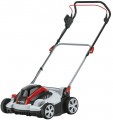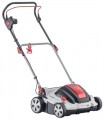Motor type
Type of engine installed in the aerator.
—
Electric (mains). Mains powered electric motors. The main advantages of all electric motors, regardless of the type of power supply, are the low cost of both the units themselves and electricity, ease of maintenance, an absolute minimum of consumables (usually, you have to buy something for such a motor only in case of malfunctions or breakdowns), as well as a low noise level and the complete absence of emissions into the atmosphere. Among the shortcomings, in comparison with gasoline, one can note a relatively low power. However, in this category there are also quite solid models in terms of power, which may have problems except for the most complex work. But the unequivocal disadvantage of network aerators is the need for a nearby outlet and various inconveniences due to the presence of a power wire. However the length of this wire can be quite large, and many units of this type are quite suitable for processing a medium-sized lawn in the yard of a private house, in extreme cases, you can use an extension cord.
—
Electric (battery). Battery powered electric motor. Such models have all the advantages of electric motors described above; the battery makes the device as autonomous as possible, allowing you to work even if there are no outlets nearby. And the absence of a power cord, which can get underfoot, can also be attributed to dignity. On the
...other hand, battery units are noticeably more expensive and weigh more than similar mains-powered models, their power is lower than that of gasoline ones, and the operating time is limited — and after the charge is exhausted, the battery needs to be charged, which takes quite a lot of time. However the latter can be partly offset by the use of replaceable batteries and the ability to buy a spare battery in such a way that one battery is charged while the second one is being used. Anyway, battery models are relatively rare; it is worth paying attention to such aerators if you need an autonomous unit, however, gasoline-powered devices are not suitable for one reason or another.
— Petrol. Internal combustion engines (ICE) on gasoline. Such motors provide more power than the electric motors described above, while they are completely autonomous and do not depend on the presence of outlets nearby. On the other hand, internal combustion engines are noticeably more expensive (and gasoline is expensive for them), more difficult to maintain, very noisy and produce exhaust gases. Therefore, such engines are used only in the most performant aerators designed to process large spaces — it is for such units that the combination of high power with battery life is almost mandatory. Note that gasoline models are either verticutters or a combined type (see above); There are no “clean” scarifiers among them, because a rake aerator simply does not require high power.
— Without motor (manual). Aerators that do not have any engine and work at the expense of the user's muscular strength. Usually they are devices in the form of a frame with a working shaft and a handle, with which the operator pushes the structure in front of him. Such units are extremely simple, compact, light and inexpensive, but their functionality is very limited — for example, there is no question of collecting garbage from the treated area.Motor power
The power of the aerator motor, expressed in watts. Today, the watt is the common unit of power and is used for both electric and petrol models (see "Engine type"). In general, the
more powerful the motor, the higher the performance of the unit, the greater the depth of processing and the working width (see above) can be provided in the aerator; however, the consumption of electricity / fuel also directly depends on the power. Therefore, when choosing an engine for their equipment, manufacturers proceed from a reasonable compromise between these properties, and in general, engine power allows you to evaluate the performance of the unit and its suitability for large volumes of work.
Supply voltage
Nominal voltage of the accumulator installed in the aerator of the appropriate design (see "Engine type").
When choosing, this parameter is purely reference: manufacturers select the voltage so that it meets the needs of a particular unit. And after the purchase, voltage data may be needed only when looking for a spare / replacement battery or a third-party charger.
Compatible batteries
The name of the battery that is compatible with the device. It helps to buy a spare or find a suitable one in case of a breakdown of the main one.
Battery
This paragraph indicates the features of the battery aerator configuration (see "Engine type"). The standard option is the presence of one battery in the package; here are the options that differ from the standard:
— Not included. No battery included. At first glance, this option is inconvenient, because the device cannot be used out of the box — you must first provide it with a battery. However, this configuration also has its advantages. Firstly, the battery can be selected at your discretion, without relying on the choice of the manufacturer. Secondly, some manufacturers produce universal batteries suitable for different types of power tools and units; if the “household” already has a tool with such a battery, it can be used in an aerator of the same brand and not overpay for another battery (the main thing is to make sure it is compatible).
— 2 pcs in a set. Two batteries included in delivery. The most obvious advantage of this configuration is the increase in continuous operation time: if one battery is dead, you can install another one and continue the process. In addition, the presence of several batteries allows you to reduce or eliminate interruptions in charging: while one battery is in use, the second can be charged.
Noise level
The noise level produced by the aerator during operation. It is worth noting that this indicator can be indicated in different ways: some manufacturers give the maximum noise level in the characteristics, others give average values \u200b\u200bduring normal operation, etc. Anyway, this information allows you to assess the noise level of the unit and, if necessary, provide protective measures — for example, get headphones in advance.
When evaluating specific loudness values, note that the decibel used to indicate the noise level is a non-linear value. Therefore, it is easiest to evaluate specific values using comparative tables. Here is a simplified table for the range that most modern aerators fit into:
70 dB — a conversation of several people in raised tones.
75 dB — high power vacuum cleaner.
80 dB — traffic noise on a busy street.
85 dB — motorcycle engine with muffler in close proximity;
90 dB — freight car at a distance of 7 – 10 m;
95 dB — noise in the subway car on the stage;
100 dB — industrial shop.

